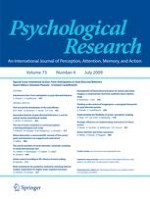01-07-2009 | Original Article
Tool use and the distalization of the end-effector
Gepubliceerd in: Psychological Research | Uitgave 4/2009
Log in om toegang te krijgenAbstract
We review recent neurophysiological data from macaques and humans suggesting that the use of tools extends the internal representation of the actor’s hand, and relate it to our modeling of the visual control of grasping. We introduce the idea that, in addition to extending the body schema to incorporate the tool, tool use involves distalization of the end-effector from hand to tool. Different tools extend the body schema in different ways, with a displaced visual target and a novel, task-specific processing of haptic feedback to the hand. This distalization is critical in order to exploit the unique functional capacities engendered by complex tools.
